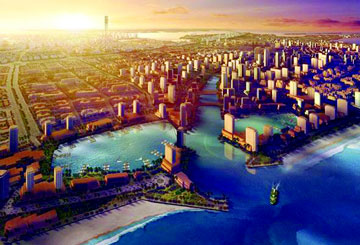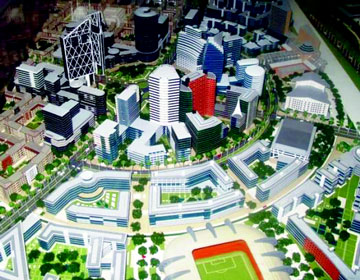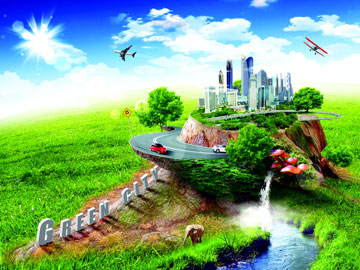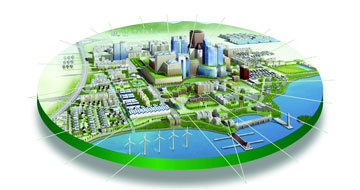Build Cities for Better Living
Ar. Swati Kiran
The Present Scenario

India faces unprecedented urbanisation in the coming decades. As dependence on agriculture in rural areas reduces and offers limited financial stability due to a host of problems, the population is migrating to cities in search of a better life. Our cities that are themselves struggling to keep pace with their own growth are reeling under the burden of providing for the influx. Once vibrant cities are becoming saturated with slums and are providing a pitiable quality of life for the majority of its residents. This scenario is played out the world over. Some megacities identified on the basis of continuing growth like Tokyo, Jakarta, Moscow, Paris, Los Angeles and many others have populations in excess of 10 million.BBC news reported in early 2013 that 260 million people live in 30 megacities worldwide. In the next few decades more than 70% of the world’s peoples will reside in cities. A recent UN census places the world population at over 7 billion which is a cause for concern as it is resulting in irreparable depletion of fossil fuels and water, deforestation, desertification, species extinction, poverty, malnutrition, pandemics and global strife. The problems besetting us today like global warming causing erratic weather, biodiversity loss, gridlocked streets, pollution and a host of others will continue unless action is taken. Sustainable development, the buzz word bandied about for the past decade seems to exist on paper in most regions. The good work being done by eco warriors is not enough anymore. We need to seriously look at building cities for better living. Better for humanity and for the planet we call home.
 |
Being the Solution
 |
UNESCO has asked the International Association of Architects to focus on the problems of beleaguered megalopolises. At the International Conference on Learning Cities on 21.10.2013 in Beijing, 500 mayors, academic experts and planners from some 200 cities across the world met to discuss how to “mobilise cities to use their resources and potential to promote lifelong learning for all”. UNESCO reports that the exchange of ideas concluded with “Call to Action, to establish a global network of learning cities to support and accelerate the practice of lifelong learning in the world’s communities.” The outcome of this forum was that the common man was also invited to become an active partner in solving issues concerning our built environment resulting in a sense of participation, ownership and accountability. It has now been established that irresponsible urban growth causes detrimental climatic change. A very tenuous relationship has sprung up between society and the ecosystem it inhabits because even though a symbiotic dependence is possible, humans are depleting and finally destroying their surroundings. Some key areas where we can salvage some control over the damaging scenario are:
- Pollution control - An out of control population spike in recent years has put pressure on all systems that support our living standards. The WHO has tabled stringent air quality standards, those that many major cities fall short of. However some countries like China reports BBC, face these issues in their major urban centres but are very focussed on solving the problem. They hope to cut down on the use of coal in industries, reduce dependency on vehicles or at least propose green automobiles, revert to the use of bicycles and trains, renewable energy like solar, wind and hydroelectric power. Economic growth is being planned based on reduction of poverty and increased awareness of public health.
- Decentralization - in the Indian context counter- urbanisation seems the answer to the overburdening of urban centres. In developed nations where transportation and suburban infrastructure is advanced populations are moving out from congested centres like London and into quieter city outskirts while commuting to their workplace in the city. To make this a viable alternative in India, economic incentives should be provided to urge the migration to rural areas and entice the younger generation to stay in their villages and developing towns and cities. Some Indian enterprises, that focus on such rural growth as part of a corporate social responsibility initiative or as a philanthropic gesture are to be lauded. They invest in infrastructure to offer job opportunities to educated rural youth in their home environments that stop them from migrating in search of jobs and agriculturists are supported with latest methodologies and finance to keep the Indian rural sector strong and motivated.
- Going green - With the world population creeping perilously close to the carrying capacity of the Earth, application of green technologies is long overdue. The term applies to utilising sustainable methods of generating energy like photovoltaic, solar power, wind turbines, bioreactors and water power in a bid to regenerate the lost biodiversity and conserve energy. One architectural solution is Green roofs or eco roofs, also called living roofs because they consist of a layer of vegetation atop the building giving rise to advantages like absorbing rainwater by preventing run off; insulating the space below; cutting energy costs; and helping to mitigate the Urban Heat Island Effect that causes buildings to trap heat in urban centres and raise temperatures. Green walls that are vertical vegetation provide numerous benefits like energy efficiency, protecting the structure and improving air quality. The added advantage is they are aesthetically stimulating due to their effect of luxurious vegetation on the elevation of the built surface.
 |
Nations have also been championing the cause of reducing the ‘carbon footprints’ of products, people and organizations. The Kyoto Protocol is an international agreement that has set internationally binding targets for the reduction of emissions. This in simple terms is the measure of anthropogenic greenhouse gases emitted that abets global warming. According to the UNFC report “Parties involved have committed to reduce GHG emissions by at least 18 % below 1990 levels in the eight-year period from 2013 to 2020.” Architects and the building industry have been consolidated in their efforts to help this cause by designing green buildings. By this method the process of construction ensures efficient use of resources like water and energy and the design further enhances this saving during the life of the structure. Use of natural building materials, renewable energy sources and maximum use of natural light and ventilation are some of the basic tenets in use today. Cement and concrete manufacturing companies are doing their bit in trying to promote emerging green alternatives in the production of this material that significantly reduces the CO2 added to the environment.
A Better Future
Urban centres in our future will have an environmentally aware conscience. One example that inspires is the skyscraper Taipei 101 in Taiwanthat has impressive credentials, being 508 m tall from ground to the top of its spire. However it is also a trend setter in an area that most buildings aspire to it has been awarded the LEED(Leadership in Energy and Environmental Design) Platinum certification demonstrating that it is a truly green building in spite of its size. A growing number of buildings are aiming at ‘net zero’ a measure denoting that they use only as much energy as they produce.
An Interesting talk at TED by Michael Green has a diametrically opposite view that we should promote tall building in wood to meet housing demands without increasing carbon emissions. This promotes questions like, ‘what about structural stability, deforestation, sustainability?’ These are best answered by hearing the man himself at: www.ted.com .
Architect Ken Yeang’s Solaris in Singapore is an example of how we should envisage the future of habitation. This is a completely ecological site with a 108% ratio of landscaped to site area as a green ramp winds its way around the building connecting to green spaces that are built into the façade at each level.
Necessity is the mother of invention and the conundrum of habitation that is besieging innovators of today throws up interesting answers to this puzzle. National Geographic reports a few: The Seascraper is aneco-friendly floating city that is a concept for offshore sustainable development; the Waterscraper is an underwater residence with a floating ring and transparent dome visible on the surface. Paul Peachey of the New Zealand Herald reports that Seasteads are the cities of the future. These will be "communities of like-minded, self-governing individuals established on the high seas, free from what proponents see as the restrictions of nations, welfare systems and punitive taxes. Seasteading has emerged as a political movement - with nods to climate change and land shortages - to create new water-borne city states. The design consultants envisage a series of interlocking "hollow box" square and pentagonal platforms, allowing each city to grow organically - or be dismantled and towed away in the event of political dispute or interference. Early residents would live in flats of 70sq m with terraces open to the sea. Solar energy would power general daily living, including electric-only cookers, while water for showers and drinking would be supplied by the rain."
 |
"Building art is a synthesis of life in materialised form. We should try to bring in under the same hat not a splintered way of thinking, but all in harmony together" said Alvar Aalto. There is a resounding truth in his words, a call to arms to build a better environment in a cohesive manner.
References
QUOTES
Building art is a synthesis of life in materialised form. We should try to bring in under the same hat not a splintered way of thinking, but all in harmony together-Alvar Aalto.
An out of control population spike in recent years has put pressure on all systems that support our living standards. The WHO has tabled stringent air quality standards, those that many major cities fall short of.
Nations have also been championing the cause of reducing the ‘carbon footprints’ of products, people and organizations. The Kyoto Protocol is an international agreement that has set internationally binding targets for the reduction of emissions.
India faces unprecedented urbanisation in the coming decades. As dependence on agriculture in rural areas reduces and offers limited financial stability due to a host of problems, the population is migrating to cities in search of a better life.